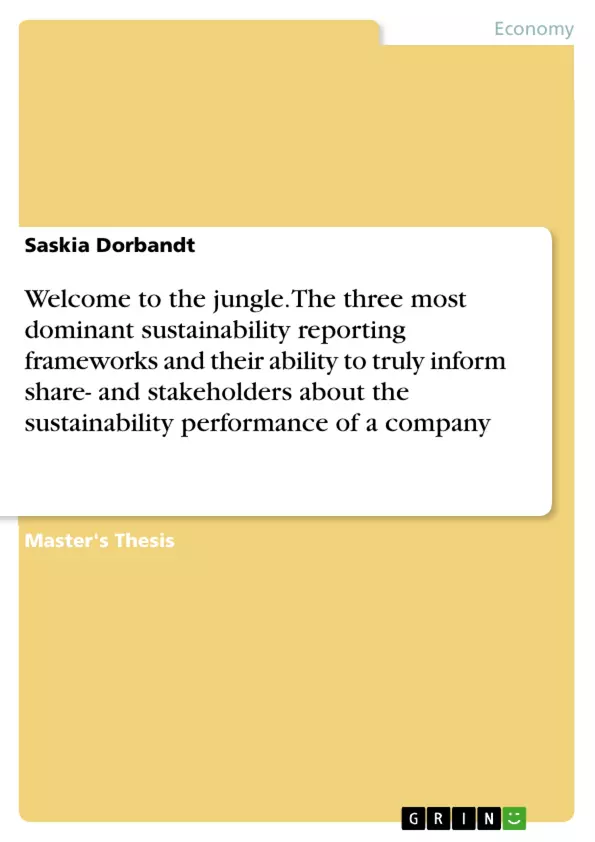Today, the information demand about the sustainability related performance of companies is higher than ever. Share- as well as stakeholders require transparent information to be able to evaluate and compare companies on the basis of their sustainability performance. The research aim of this thesis is to distinguish the three most dominant reporting frameworks in 2020. Their ability to provide share- and stakeholders with comprehensive insights about the sustainability performance of companies will be analysed. The frameworks considered are GRI, SASB and TCFD. The expectations of share- and stakeholders towards sustainability information have been defined on the basis of four chosen representatives (WWF, EU, BlackRock and Norges Bank Investment Management) alongside the UN Sustainable Development Goals. Their expectations have been compared to the three reporting frameworks, on their ability to meet these. Based on the analysis, the GRI reporting framework shows the most comprehensive format of the three compared frameworks. Compared to SASB and TCFD, GRI is also the only framework that does have a global reach and covers all aspects of the triple bottom line of sustainability reporting. SASB is limited with it´s focus on the financial filing format for public companies in the U.S. and TCFD with it´s focus on the financial impact of climate change.
Inhaltsverzeichnis (Table of Contents)
- Reporting on Sustainability
- Introduction
- Research Objective
- Development of the sustainability movement for companies
- Link between Sustainability and CSR
- Link between Sustainability and ESG
- Organizations
- Organizations
- Countries
- Rating Agencies
- Most Dominant Reporting Frameworks
- Global Reporting Initiative (GRI)
- Sustainability Accounting Standards Board (SASB)
- Task-Force on Climate-Related Financial Disclosures (TCFD)
- Share- and Stakeholders
- Definition
- Information demand representatives
- World Wide Fund for Nature (WWF)
- European Union (EU)
- BlackRock
- Norges Bank Investment Management (NBIM)
- Analysis on how sustainability reporting frameworks meet information needs
- View on materiality
- View on materiality - GRI
- View on materiality - SASB
- View on materiality - TCFD
- Sustainability performance information
- Sustainability Performance - GRI
- Sustainability Performance - SASB
- Sustainability Performance - TCFD
- Result and Discussion
Zielsetzung und Themenschwerpunkte (Objectives and Key Themes)
This thesis aims to analyze the three most prominent sustainability reporting frameworks, namely GRI, SASB, and TCFD, in terms of their ability to provide comprehensive insights about the sustainability performance of companies to both shareholders and stakeholders. The study examines the extent to which these frameworks fulfill the information needs of key stakeholders, including the WWF, EU, BlackRock, and Norges Bank Investment Management, based on their expectations and the UN Sustainable Development Goals.
- The growing demand for transparent sustainability information from companies.
- The importance of meeting the information needs of diverse stakeholders.
- The evaluation of the effectiveness of different sustainability reporting frameworks.
- The role of materiality in sustainability reporting.
- The alignment of reporting frameworks with the UN Sustainable Development Goals.
Zusammenfassung der Kapitel (Chapter Summaries)
- Reporting on Sustainability: This chapter sets the context by introducing the concept of sustainability reporting and its evolving landscape. It explores the relationship between sustainability, corporate social responsibility (CSR), and environmental, social, and governance (ESG) factors. The chapter also discusses the historical development of the sustainability movement and identifies key stakeholders involved.
- Most Dominant Reporting Frameworks: This chapter delves into the three most prominent sustainability reporting frameworks: GRI, SASB, and TCFD. It provides an overview of each framework's structure, scope, and reporting requirements.
- Share- and Stakeholders: This chapter focuses on the diverse group of stakeholders interested in sustainability information. It defines the concept of stakeholders and identifies key representatives, including the WWF, EU, BlackRock, and Norges Bank Investment Management. The chapter also highlights the information needs and expectations of these stakeholders regarding sustainability performance.
- Analysis on how sustainability reporting frameworks meet information needs: This chapter examines the ability of the three frameworks to meet the information needs of stakeholders. It analyzes the frameworks' approaches to materiality and the provision of sustainability performance information.
Schlüsselwörter (Keywords)
This master's thesis explores the domain of sustainability reporting, focusing on the effectiveness of different reporting frameworks. It utilizes key concepts like corporate social responsibility (CSR), environmental, social, and governance (ESG) factors, and the UN Sustainable Development Goals (SDGs). The study examines the information needs of key stakeholders, such as the WWF, EU, BlackRock, and Norges Bank Investment Management, in relation to materiality, transparency, and comprehensive reporting. The research analyzes and compares three dominant frameworks: the Global Reporting Initiative (GRI), the Sustainability Accounting Standards Board (SASB), and the Task-Force on Climate-Related Financial Disclosures (TCFD).
- Quote paper
- Saskia Dorbandt (Author), 2020, Welcome to the jungle. The three most dominant sustainability reporting frameworks and their ability to truly inform share- and stakeholders about the sustainability performance of a company, Munich, GRIN Verlag, https://www.grin.com/document/974480



